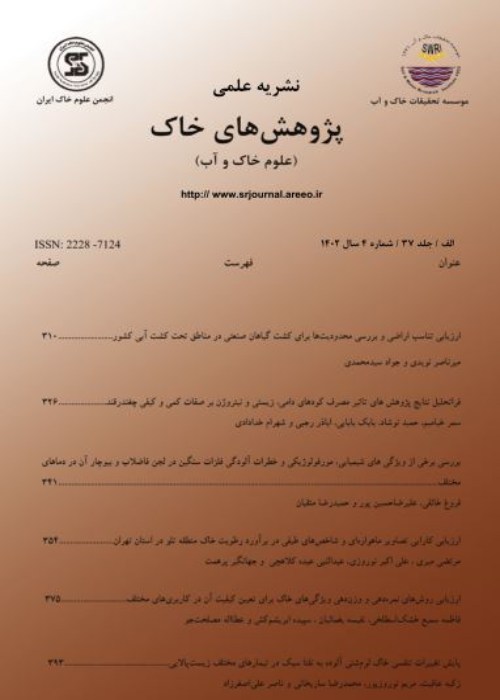Effects of Clay Content and Salinity on Volumetric Water Content Using Time Domain Reflectometry
Author(s):
Abstract:
Measurement of soil water content is important in hydrology, agriculture, and pedology. To this end, use of methods that can measure soil water content in a natural and safe condition with high speed and accuracy is very important. Recently, the use of Time Domain Reflectometry (TDR) has become common for quick measurement of soil salinity and volumetric water content. This study aimed to assess the effect of clay content and soil salinity on dielectric constant (volumetric water content) in saline and non-saline soils. At all five sites, both the topsoil (0-0.3 m depth) and the subsoil (0.3-0.6 m depth) were sampled. These soil samples were poured into 15-20 cylinders (sub-samples) depending on their clay content. Afterwards, pure water was repeatedly added to some sub-samples at the rate of 0.025 m3 m-3, while the others received 0.03m3m-3 saline water (EC of 0.41,0.81,1.53,2.6,3.49,4.71 dSm-1) in repeated doses until the water content was close to saturation in each subsample. The samples were then weighed and packed to reach the same bulk density as originally measured in the field. After 24-48 hrs, the TDR measurement was performed. Soil physico-chemical parameters, including organic matter, clay, silt, and sand contents and clay mineralogy were determined. The results showed that higher soil salinity increased soil dielectric constant i.e. both the rise time of the reflected signal and the total time delay increased, resulting in overestimation of soil moisture. The bound water in clay soil reduced the time delay because of its lower dielectric constant caused by specific surface area and affected on polarity of water near the particles, resulting in underestimation of soil water content. There is a turning point moisture, at which the effect of bound water is balanced by the effect of soil electrical conductivity. Also results show that only in one point linear model shows an accurate water measurement; below this point, bound water effect dominates and TDR underestimates soil moisture. Above this point, the effect of soil EC dominates and TDR overestimates soil moisture. This turning point moisture decreases as the soil salinity increases. Overall, the results show that for accurate measurement and avoidance of large errors in measurement of volumetric water content with TDR, salinity and mineralogy of clay content must be included in the calibration equation
Language:
Persian
Published:
Iranian Journal of Soil Research, Volume:25 Issue: 2, 2011
Pages:
103 to 112
magiran.com/p910078
دانلود و مطالعه متن این مقاله با یکی از روشهای زیر امکان پذیر است:
اشتراک شخصی
با عضویت و پرداخت آنلاین حق اشتراک یکساله به مبلغ 1,390,000ريال میتوانید 70 عنوان مطلب دانلود کنید!
اشتراک سازمانی
به کتابخانه دانشگاه یا محل کار خود پیشنهاد کنید تا اشتراک سازمانی این پایگاه را برای دسترسی نامحدود همه کاربران به متن مطالب تهیه نمایند!
توجه!
- حق عضویت دریافتی صرف حمایت از نشریات عضو و نگهداری، تکمیل و توسعه مگیران میشود.
- پرداخت حق اشتراک و دانلود مقالات اجازه بازنشر آن در سایر رسانههای چاپی و دیجیتال را به کاربر نمیدهد.
In order to view content subscription is required
Personal subscription
Subscribe magiran.com for 70 € euros via PayPal and download 70 articles during a year.
Organization subscription
Please contact us to subscribe your university or library for unlimited access!


